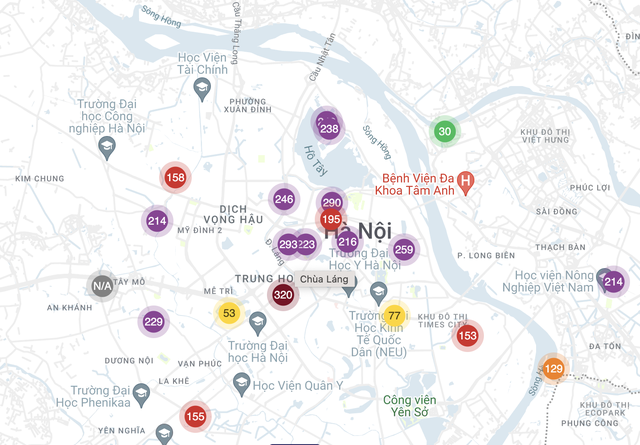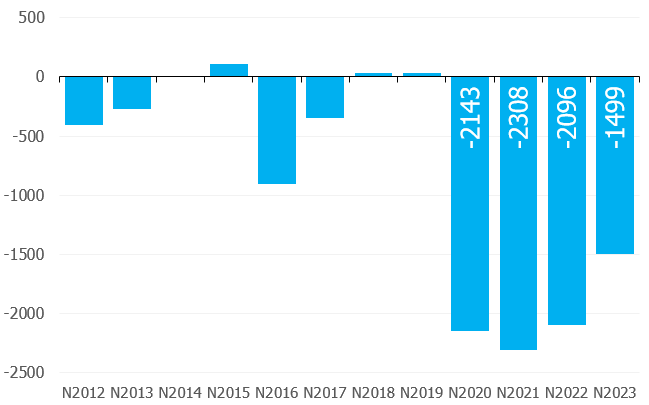Air pollution in Hanoi continues to increase
In recent days, the air pollution situation in the capital city of Hanoi has become increasingly serious, causing many residents to feel concerned every time they have to go out. At times, Hanoi has even ranked first in the world in terms of air pollution.
According to air pollution monitoring data from Pam Air (a reference channel for air quality trends in various locations in Vietnam), at 9:30 am on February 2, the AQI index at many points in Hanoi mostly ranged above 200 units, which is a very bad level and poses a health risk.

The AQI index at many points in Hanoi mostly ranged above 200 units on the morning of February 2.
At the same time, IQAir (an application that monitors air quality worldwide) ranked Hanoi as the top city in terms of air pollution with an average AQI index of 257 units.

Hanoi ranked first in terms of air pollution with an average AQI index of 257 units
Air pollution is becoming increasingly serious and was addressed at the recent 31st session of the Standing Committee of the National Assembly. During the meeting, the issues of traffic congestion and air pollution were mentioned as the two biggest problems in Hanoi. In particular, many people mentioned that “many foreigners say Hanoi is amazing, but the air quality is terrible”.
The air pollution in Hanoi has led to an increase in respiratory diseases, such as respiratory and throat infections, and some people even experience difficulty breathing and headaches when outdoors. Mr. Nguyen Dinh Tuan (Cau Giay, Hanoi) said that living in heavily polluted air, he often feels stuffy nose and has difficulty breathing. For nearly a month now, he has been afraid to exercise outdoors in the early morning.
If this situation persists and effective measures to mitigate it are not implemented, Mr. Tuan believes it will be very dangerous for the people. He suggests that parents should take their children to the outskirts of the city to breathe cleaner air during the weekends.
Harsh air pollution prompts Hanoi residents to look for homes in the suburbs
As air pollution in Hanoi becomes increasingly severe, surrounding projects have released a series of information for sales. Various slogans for resort projects and suburban plots such as “second home away from air pollution” or “immerse yourself in nature to avoid fine dust” have been used. These projects are all located within a 30-minute drive from the center of Hanoi, with convenient transportation links.
A typical example is Casa Del Rio Hoa Binh Resort, a 142-ha project recently introduced to the market, highlighting the proximity to nature with original multi-level natural landscapes: one side is backed by a mountain forest, and the other side is adjacent to a more than 4km stretch of the Da River; surrounded by over 200 ha of water surface of the Da River, making it a “natural negative ion production station” that is highly beneficial to health.
In addition to Casa Del Rio Hoa Binh Resort, ahead of that, Ecopark Urban Area (Hung Yen) also announced the results of air quality monitoring conducted by the Environmental Science and Technology Institute (Belongs to Hanoi University of Science and Technology) as a selling point. Specifically, Ecopark stated that there have been times when harmful air index levels in the ecological urban area were much lower than the Vietnam standard. Particularly, the dangerous 2.5PM fine dust concentration measured here was 24 μg/m3, well below the WHO and EU countries’ safe threshold (25 μg/m3).
The reality shows that when air pollution in Hanoi reaches a critical level, people with means are looking for a healthier living environment in the outskirts. Distance is no longer a barrier as highways connecting the central areas to the suburbs have been completed, and many people are willing to commute further to have a more comfortable and cleaner living space.
Mr. Nguyen Binh (55 years old, Ph.D. in Economics) said that because he had lived abroad for a long time, he felt very suffocated when returning to Hanoi, especially during periods of severe air pollution. With their children studying abroad and only a couple living at home, he decided to move to Hoa Binh: “With 10 billion, I can buy a luxurious villa in Hoa Binh. The Hoa Binh – Lang Hoa Lac highway has been completed, so commuting to My Dinh in the morning only takes more than 30-40 minutes,” Mr. Binh said.

Natural multi-level landscapes in suburban areas are attracting homebuyers.
Ms. Duong Thuy Dung, Senior Director, Head of Research Department at CBRE Vietnam, said that environmental pollution from dust, noise, and traffic congestion in the city center are leading residents to consider buying homes in the outskirts of Hanoi. She emphasized that land reserves in the central areas are becoming scarce, resulting in higher prices and a tendency for people to move away from the center.
“We have observed a shift in real estate preferences over the past two years. For a long time, we talked about ‘ghost towns’ and deserted areas far from the city center due to inadequate infrastructure. Now that the infrastructure is ready, the demand and purchasing power have increased. These satellite towns are fully occupied despite being far from the center. These areas far from the center come with integrated amenities,” Ms. Dung commented.










































